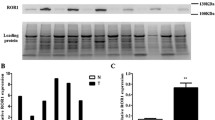Abstract
PR (PRDI-BF1 and RIZ) domain containing proteins (PRDM) have been indicated to play important roles in several human cancers. The objectives of this study were to determine the frequency and prognostic significance of PRDM1 and PRDM14 expression in a cohort of surgically resected non-small cell lung cancer (NSCLC) patients. Immunohistochemistry and Western blotting was used to detect the expression status of PRDM1 in primary tumors and PRDM14 for both primary lung cancers and matched lymph node metastases. Univariate and multivariate analysis were performed to determine the association between PRDM expression and prognosis. PRDM1 expression was observed in all NSCLC patients’ tumor samples. PRDM14 was found to be increased expression in 35.65 % cases (46/129) for primary tumors and 39.68 % cases (25/63) for paired metastatic lymph nodes. Increased expression of PRDM14 correlated with differentiation of tumor cells significantly (P = 0.008). Western blotting analysis verified that PRDM14 associated with cell differentiation in NSCLC. The overall survival rates of patients with high PRDM14 expression and low PRDM14 expression were 41.30 and 65.06 %, respectively (hazard ratio: 3.051, 95 % CI: 1.752, 5.312, P < 0.0001). The progression-free survival rates were 34.78 % for patients in the high expression group and 59.03 % for patients in the low OLC1 expression group (hazard ratio: 2.775, 95 % CI: 1.648, 4.675, P < 0.0001). Thus, our study showed that increased expression of PRDM14 correlated with cell differentiation of NSCLC cells. PRDM14 was a potential biomarker for predicting unfavorable prognosis in NSCLC.



Similar content being viewed by others
References
Siegel R, Naishadham D, Jemal A. Cancer statistics, 2012. CA Cancer J Clin. 2012;62(1):10–29. doi:10.3322/caac.20138.
Esteller M. Epigenetics in cancer. New Engl J Med. 2008;358(11):1148–59. doi:10.1056/NEJMra072067.
Risch A, Plass C. Lung cancer epigenetics and genetics. Int J Cancer J Int Du Cancer. 2008;123(1):1–7. doi:10.1002/ijc.23605.
Bannister AJ, Kouzarides T. Reversing histone methylation. Nature. 2005;436(7054):1103–6. doi:10.1038/nature04048.
Bikoff EK, Robertson EJ. One PRDM is not enough for germ cell development. Nat Genet. 2008;40(8):934–5. doi:10.1038/ng0808-934.
Fog CK, Galli GG, Lund AH. PRDM proteins: important players in differentiation and disease. BioEssays News Rev Mol Cell Dev Biol. 2012;34(1):50–60. doi:10.1002/bies.201100107.
Kurimoto K, Yamaji M, Seki Y, Saitou M. Specification of the germ cell lineage in mice: a process orchestrated by the PR-domain proteins, Blimp1 and Prdm14. Cell Cycle. 2008;7(22):3514–8.
Tsuneyoshi N, Sumi T, Onda H, Nojima H, Nakatsuji N, Suemori H. PRDM14 suppresses expression of differentiation marker genes in human embryonic stem cells. Biochem Biophys Res Commun. 2008;367(4):899–905. doi:10.1016/j.bbrc.2007.12.189.
John SA, Garrett-Sinha LA. Blimp1: a conserved transcriptional repressor critical for differentiation of many tissues. Exp Cell Res. 2009;315(7):1077–84. doi:10.1016/j.yexcr.2008.11.015.
Tam W, Gomez M, Chadburn A, Lee JW, Chan WC, Knowles DM. Mutational analysis of PRDM1 indicates a tumor-suppressor role in diffuse large B-cell lymphomas. Blood. 2006;107(10):4090–100. doi:10.1182/blood-2005-09-3778.
Struski S, Doco-Fenzy M, Cornillet-Lefebvre P. Compilation of published comparative genomic hybridization studies. Cancer Genet Cytogenet. 2002;135(1):63–90.
Nishikawa N, Toyota M, Suzuki H, Honma T, Fujikane T, Ohmura T, et al. Gene amplification and overexpression of PRDM14 in breast cancers. Cancer Res. 2007;67(20):9649–57. doi:10.1158/0008-5472.CAN-06-4111.
Chadwick RB, Jiang GL, Bennington GA, Yuan B, Johnson CK, Stevens MW, et al. Candidate tumor suppressor RIZ is frequently involved in colorectal carcinogenesis. Proc Nat Acad Sci USA. 2000;97(6):2662–7. doi:10.1073/pnas.040579497.
Deng Q, Huang S. PRDM5 is silenced in human cancers and has growth suppressive activities. Oncogene. 2004;23(28):4903–10. doi:10.1038/sj.onc.1207615.
Watanabe Y, Toyota M, Kondo Y, Suzuki H, Imai T, Ohe-Toyota M, et al. PRDM5 identified as a target of epigenetic silencing in colorectal and gastric cancer. Clinical Cancer Res Off J Am Assoc Cancer Res. 2007;13(16):4786–94. doi:10.1158/1078-0432.CCR-07-0305.
Rami-Porta R, Crowley JJ, Goldstraw P. The revised TNM staging system for lung cancer. Ann Thorac Cardiovasc Surg Off J Assoc Thorac Cardiovasc Surg Asia. 2009;15(1):4–9.
Travis WD. Pathology and genetics of tumors of the lung, pleura, thymus and heart. France: IARC; 2004.
Garcia JF, Roncador G, Garcia JF, Sanz AI, Maestre L, Lucas E, et al. PRDM1/BLIMP-1 expression in multiple B and T-cell lymphoma. Haematologica. 2006;91(4):467–74.
Chen J, Chen L-J, Yang R-B, Xia Y-L, Zhou H-C, Wu W, et al. Expression and clinical significance of apolipoprotein E in pancreatic ductal adenocarcinoma. Med Oncol. 2013;30(2):1–7.
Wood AJ, Spira A, Ettinger DS. Multidisciplinary management of lung cancer. New Engl J Med. 2004;350(4):379–92.
Goldstraw P, Ball D, Jett JR, Le Chevalier T, Lim E, Nicholson AG, et al. Non-small-cell lung cancer. Lancet. 2011;378(9804):1727–40.
Aggarwal C, Somaiah N, Simon GR. Biomarkers with predictive and prognostic function in non-small cell lung cancer: ready for prime time? J Nat Compr Cancer Netw JNCCN. 2010;8(7):822–32.
Györy I, Fejér G, Ghosh N, Seto E, Wright KL. Identification of a functionally impaired positive regulatory domain I binding factor 1 transcription repressor in myeloma cell lines. J Immunol. 2003;170(6):3125–33.
Waller LL, Weaver KE, Petty WJ, Miller AA. Effects of continued tobacco use during treatment of lung cancer. Exp Rev Anticancer Ther. 2010;10(10):1569–75.
Acknowledgments
This study was supported by the Provincial science and technology foundation of Shandong (2011GG21819).
Conflict of interest
None.
Author information
Authors and Affiliations
Corresponding authors
Additional information
Tiehong Zhang and Long Meng contributed equally to this work.
Rights and permissions
About this article
Cite this article
Zhang, T., Meng, L., Dong, W. et al. High expression of PRDM14 correlates with cell differentiation and is a novel prognostic marker in resected non-small cell lung cancer. Med Oncol 30, 605 (2013). https://doi.org/10.1007/s12032-013-0605-9
Received:
Accepted:
Published:
DOI: https://doi.org/10.1007/s12032-013-0605-9




